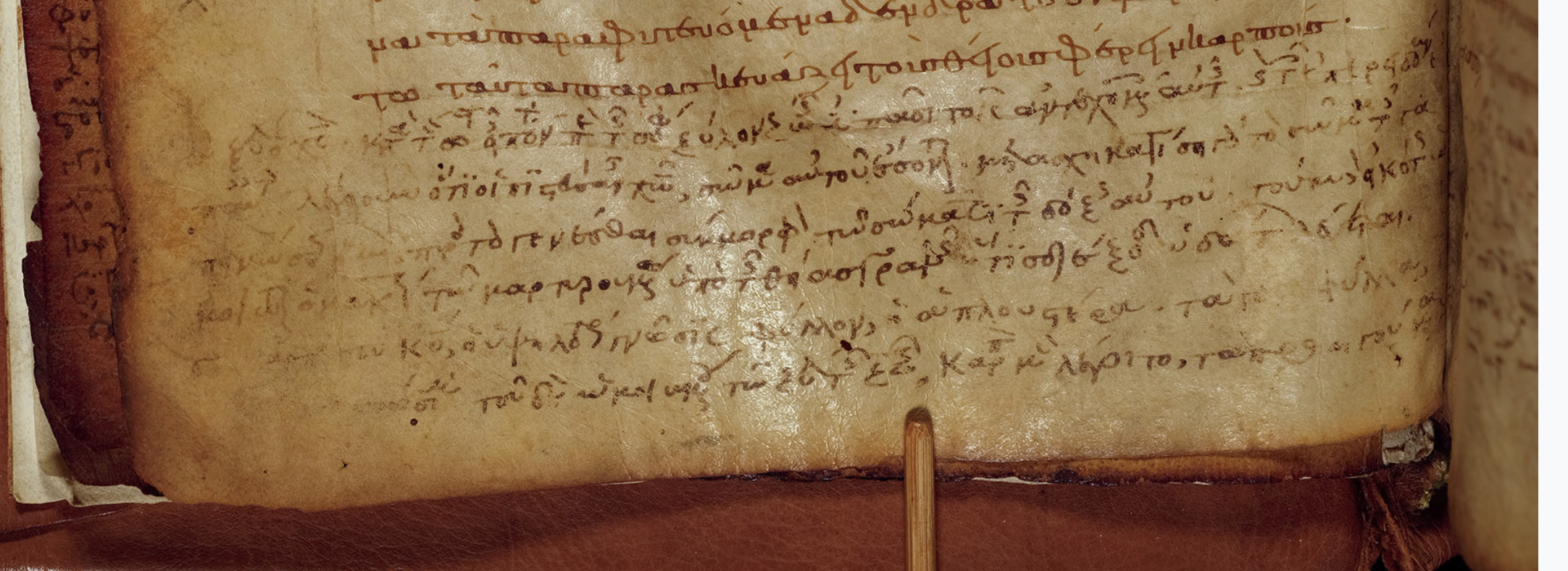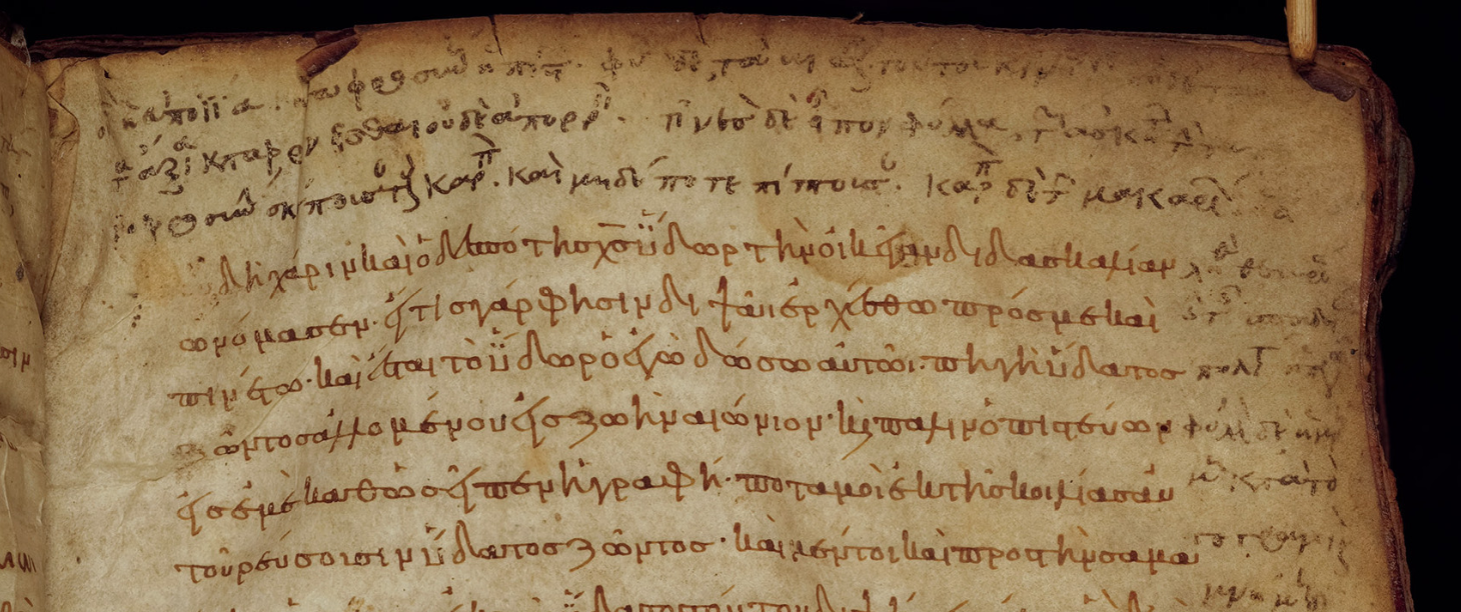
Athanasius in the Margins: A Study of Some Scholia in Rahlfs 9075
Jonathan Groß
October 7, 2024
Among the manuscripts with Theodoret’s Commentary on the Psalms (CPG 6202), many are adorned with marginal notes.1 In this article I discuss a few examples from Rahlfs 9075 (Venice, Biblioteca Nazionale Marciana gr. II 184, Diktyon 70354), a parchment codex from the library of Zan Carlo Grimani (1648–1714) which is housed in the Biblioteca Marciana since 1816.2 The codex, dated to the 10th century by Bernard de Montfaucon,3 has suffered a loss of leaves at the beginning and at the end. On the folia 2v–6v, a 13th century hand has supplied the text on palimpsested parchment leaves.4 The supplied text ends in the middle of the commentary text on Psalm 1:1 (μηδεὶς δὲ ἄνδρα μόνον = PG 80.868B13).
The last leaf (f. 436v) ends with θεωροῦμεν τὰ πράγματα = PG 80.1997A7, part of the final commentary text on Ps 150:6, which means that about 150 words are missing which would probably have fitted on on a single page. The end is exactly the same as in the manuscript Rahlfs 9046 (olim 1120; Oxford, Bodleian Library, Barocc. 132, Diktyon 47419), a composite codex where the Theodoret text consists of several parts of different origin, written between the 12th and 15th century. However, while the last leaf of Rahlfs 9046 (f. 272v, written in the 12th century) is still intact, f. 436v in Ra 9075 is torn and has suffered an extensive loss of text.
As noted by Mioni, a 13th century scholarly hand has annotated the text in Rahlfs 9075 with copious marginal and interlinear notes until Psalm 43; however, the vast majority of these notes is found only until Psalm 21 (f. 60r), after which there are significantly fewer annotations. I cannot say with certainty whether all the notes are written by one scribe or several scribes. At first glance, the style and the ink seem to suggest at least two different individuals. Be that as it may, the marginalia consist of exegetical notes, glosses and, to a large part, of excerpts from catenae commentaries which are frequently headed with abbreviated names. Out of these Mioni mentions Gregor of Nyssa, Cyril, John Chrysostom, Eusebius, Didymus and Hesychius.5 A preliminary search reveals that at least one illustrious name needs to be added to this list: Athanasius, to whom a series of Psalm commentaries (Expositiones in Psalmos, also known as Scholia in Psalmos) is attributed in the catenae tradition.
A critical edition of these Expositiones is being prepared at the Austrian Academy of Sciences (https://expps.acdh-dev.oeaw.ac.at/expps/). An examination of the marginalia in Rahlfs 9075 show that the 13th century annotator(s) made ample use of (Ps.-)Athanasius’ Expositiones in Psalmos to supplement that of Theodoret. In the following, a few examples are given with a comparison between the marginalia text and the Athanasius edition.
1. Athanasius on Ps 1:1 (Ungodly, Sinners and Pests)

Venice, Marc. gr. II 184 = Rahlfs 9075 f. 7v (detail)
© Biblioteca Marciana
The first marginal note here considered appears at the end of Theodoret’s commentary on Psalm 1:1 (PG 80.869) on the top margin of folio 7 verso. The first line of the note is difficult to decipher due to the faded ink. I read the text thus (with the compendia resolved; nomina sacra are indicated with round brackets):
[…]νεύς (?) ἀσεβῶν ἁμαρτωλων καὶ λοιμῶν. τρία γὰρ ἦν καὶ τὰ τάγ2|ματα τὰ κατὰ τοῦ Σ(ωτῆ)ρ(ο)ς ἐπαναστάντα, γραμματεῖς, φαρισσαῖοι, καὶ νομικοί· οἳ καλοῖντο,3| εἰκότως· ἀσεβεῖς ἁμαρτωλοὶ καὶ λοιμοί.
[…] of ungodly, sinners and pests. For there were three or²|ders (divisions) rising up against the Saviour: scriveners, Pharisees, and legal scholars; these may rightfully be called ungodly men, sinners and pests.
A comparison with the Athanasius edition reveals the final part (from τρία γὰρ) to be taken from Athanasius’ Expositio 1. As is to be expected in a marginal note, the text is slightly changed against the edition, omitting the words παρὰ Ἰουδαίοις after τάγματα and reading καλοῖντο instead of οἳ καὶ κληθεῖεν.
2. Athanasius on Ps 1:2a (God’s Law) and 2b (Day and Night)

Venice, Marc. gr. II 184 = Rahlfs 9075 f. 7v (detail)
© Biblioteca Marciana
On the same folio, more marginal notes as well as two short interlinear notes are also present. The first interlinear note is written above the words τῷ νόμῳ (Ps 1:2a) in line 6 which are explained as τῷ εὐαγγελικῷ δηλονότι (“that is to say, the <law of the> Gospel”) which is a verbatim quotation of Athanasius’ Expositio 4. Another interlinear note above the lemma text ἡμέρας καὶ νυκτός in line 7, reading τ(αῖς) διατάξεσιν καὶ ἐντολ(αῖς) does not resemble anything from Athanasius’ commentaries.
The marginal notes are linked to the main text by letters (α β γ δ) and symbols like the dotted obelos (÷), but due to damage (abrasion, fading of ink, small tears in the parchment) and possibly trimming of the pages, the repetition of these marks in the margins is not visible anymore (if it ever was). Judging by the peculiarities of the handwriting and the ink, three hands are discernible on this page, the first being the 10th century scribe (first hand) who added a ση(μείωσαι) mark to highlight the commentary on Ps 1:2a–b (left from line 17), and the words γ(άρ) φη(σιν) to the lemma text of Ps 1:3a (left from line 18). The second hand wrote the first marginal note on the left margin (left of the lines 7–10) as well as the note on Ps 1:1 (discussed above) and the more extensive note in the bottom margin of f. 7v, continued on the top margin of f. 8r. The third hand, from about the same period as the second hand, added an extensive note on the left margin below that of the second hand, next to the lines 11–22. The writing of this third hand is somewhat difficult to read, especially because it is affected by the trimming of the page, but the note appears to be unrelated to Athanasius.
The note on the left margin, lines 7–10, has the following text relating to Ps 1:2b:
τὸ σύντονον 2|δηλοῖ οὐ γὰρ ἠμε3|λημένως δεῖ με4|λετᾶν τὸν τοῦ 5|Κ(υρίο)υ νόμον.
This refers to intensity; 2|for one 3|must not think 4|carelessly about 5|the Lord’s law.
This is a full quotation of Expositio 5, which changes the edition’s τοῦ κυρίου τὸν νόμον to a more classical clause by transposing the article τὸν.
3. Athanasius on Ps 1:3a (The Tree of Life)

Venice, Marc. gr. II 184 = Rahlfs 9075 f. 7v (detail)
© Biblioteca Marciana
The next note concerning us (written by the second hand, again) begins on the bottom margin of f. 7v and continues on the bottom margin of the opposite f. 8r. It refers to a phrase from Ps 1:3a (καὶ ἔσται ὡς τὸ ξύλον τὸ πεφυτευμένον παρὰ τὰς διεξόδους τῶν ὑδάτων, “And he shall be as a tree planted by the brooks of waters”). The note begins (after what appear be traces of an alpha) with words taken from Athanasius’ Expositio 6, but intermixed with additions by the scribe. For clarity’s sake I first give the Greek text of the Athanasius edition and after that the Greek text and English translation of the scholium, the verbatim excerpts from Athanasius highlighted in bold.
Ξύλον ὁ Χριστὸς ἀναγέγραπται ἐν τῇ θεοπνεύστῳ γραφῇ· κατὰ τὸ εἰρημένον· ξύλον ζωῆς ἐστιν πᾶσι τοῖς ἀντεχομένοις αὐτῆς· λέγει οὖν ὅτι οἱ πιστεύσαντες Χριστῷ, σῶμα αὐτοῦ ἔσονται· μετασχηματίσει γὰρ τὸ σῶμα τῆς ταπεινώσεως ἡμῶν, σύμμορφον τῷ σώματι τῆς δόξης αὐτοῦ· διεξόδους δὲ ὑδάτων, τὰς θείας γραφάς· ἐν αἷς ἁπανταχοῦ ἔστιν εὑρεῖν Χριστὸν κηρυσσόμενον.
[τὸ (?)] ξύλον ὁ Χ(ριστὸ)ς κατὰ τὸν Σολομῶντα περὶ τῆς σοφίας· ξύλον ζωῆς ἐστι πᾶσι τοῖς ἀντεχομένοις αὐτῆς, καὶ τοῖς ἐπερειδομένοις ἐ2|π’ αὐτήν. λέγει οὖν, ὅτι οἱ πιστεύσαντες τῷ Χριστῷ σῶμα αὐτοῦ ἔσονται· μετασχηματίσει γὰρ τὸ σῶμα τῆς τα3|πεινώσεως ἡμῶν πρὸς τὸ γενέσθαι σύμμορφον τῷ σώματι τῆς δόξης αὐτοῦ. τούτῳ δὲ εἰκότως 4| …
The tree <is> Christ according to Solomon on wisdom: She is a tree of life to all who lay hold upon her, and those who retain 2|her (Prov 3:18). Thus he says that the believers in Christ will be his body; for our body of 3|humility will change to the same shape as the body of his glory (cf. Phil 3:21 var). This clearly refers to 4| …
The difference between Athanasius’ words ἀναγέγραπται ἐν τῇ θεοπνεύστῳ γραφῇ (“it is written in the divinely inspired scripture” and those of the marginal note show the scholiast’s theological learning: More specifically than (Ps.-)Athanasius he specifies the quotation as part of the Book of Proverbs (of Solomon), indicates the general theme of the quotation from Prov. 3:18 as σοφία (‘wisdom’), thus explaining the feminine pronouns in the following quotation, and finally he also quotes the words καὶ τοῖς ἐπερειδομένοις ἐπ’ αὐτήν from Prov 3:18 which are not found in the Catena manuscripts of Expositio 6.
Contrary to this, Athanasius’ final words διεξόδους – κηρυσσόμενον are not quoted by the scholiast. Instead the scholium is continued, without indication of any change of source, with the words τούτῳ δὲ εἰκότως and three more lines, continued on f. 8r (top and right margin until line 13), of which I give a tentative reading including a few helpful suggestions by Dr. Sebastiano Panteghini. As the reading is still far beyond certain, I will not attempt a translation.
4|[ὡμοίωται ὁ μακ(άριος) (?)] τῷ μαρτυρουμένῳ ὑπὸ τῆς θείας Γραφῆς [ἥ]τις (?) διέξοδός ὑδάτων λέγεται. 5| [τοῦ ?] Κ(υρίου), ἡ ὑψηλοτέρα γνῶσις φύλλον, ἡ ἁπλουστέρα. τὰ γ[ὰρ (?) ..] φύλλα, 6| […]σιμα (?). τοῦ δὲ ὡμοιωμένου τῷ ξύλῳ τῆς ζωῆς καρπὸν μὲν λέγοιτο τὰ προηγούμενα (f. 8r top) 1|οἷον ἡ εὐποιΐα, κα[τ]αφροσύνη (?) ἡ πίστίς· φύλλα δὲ τὰ βιωτικὰ τούτοῦ κινήματα, οὐδὲ ταῦ2|τα ἄξια καταφρονεῖσθαι, οὐδὲ ἀπορρεῖν. τίνες δὲ εἶπον φύλλα, τῶν ἀσκητῶν τὴν ταπει3|νοφροσύνην, σκέπουσαν τοὺς καρποὺς, καὶ μηδέποτε πίπτουσαν. καρπὸν δὲ τῶν μακαριῶν ἀ4|ληθείαν (?) …
From ἀ4|ληθείαν (?) on, the words written on the right margin are difficult to read due to faded ink. The text given above, which spans across the bottom and top margin of f. 7v and 8r respectively, is stitched together from excerpts of Origenes’ various treatises and commentaries on the Psalms. As these lie outside of the scope of this article, suffice it to say that the text from f. 7v bottom 5| ἡ ἁπλουστέρα to f. 8r top margin 2| οὐδὲ ἀπορρεῖν is very close to Origines, Selecta in Psalmos (PG 12.1089.D3–11) while text immediately afterwards, beginning with τίνες δὲ εἶπον, until 3| πίπτουσαν is taken from his Fragmenta in Psalmos (CPG 1425) 1:3.6 The text after that, beginning with καρπὸν, is yet to be identified.

Venice, Marc. gr. II 184 = Rahlfs 9075 f. 8r (detail)
© Biblioteca Marciana
5. Further Athanasiana in Rahlfs 9075
The previous four examples taken from two folia of Rahlfs 9075, while being just a small sample, demonstrate that further study of the marginal notes of this manuscript will add to our knowledge of the catenae tradition. Athanasius in particular has been used extensively by the scholiast(s), and in lieu of more detailed analyses, I just offer a few pointers to more quotations of his Expositiones in the margins:
-
f. 8v bottom margin: Athanasius, Expositio 9a on Ps 1:4a–b and Expositio 10 on Ps 1:5a–b.
-
f. 9r top and left margin: Athanasius, Expositio 11 on Ps 1:6a, followed by an excerpt marked διοδ(ώρου).
-
f. 9v top margin: Athanasius, Expositio 14 on Ps 2:1a–b (ἀπὸ κοινοῦ – γένους)
-
f. 10r, right margin next to lines 7–9: Athanasius, Expositio 14 on Ps 2:1a–b (φρύαγμά ἐστιν τὸ ἀλόγιστον φρόνημα)
-
f. 16r, left margin: Athanasius, Expositio 46 on Ps 4:3a–b and Expositio 47 on Ps 4:4a.
-
f. 28r, top margin: Athanasius, Expositio 111 on Ps 9:4a and Expositio 112 on Ps 9:4b.
6. Conclusion
Although Rahlfs 9075 it is rather modest in its presentation of Theodoret’s Commentary on the Psalms, having no decorations, illumination or even rubrication, the manuscript was used extensively after its production. Apart from the supplementation of lost folia, the text (or at least the first portion of it) was annotated by a number of 13th century scholars, making it a more useful means of studying the exegetical tradition on the Psalms. This is especially true as the excerpts chosen by the scholiasts provide christological and allegorical explanations, the likes of which are largely absent from Theodoret’s commentary but apparently sought after by the scholars who read and annotated his commentary almost a millenium later.
1I am most grateful to my colleague Dr. Margherita Matera and Dr. Sebastiano Panteghini (Vienna, Austrian Academy of Sciences) for their invaluable advice on this article.
2For detailed descriptions of the manuscript, see Felix Albrecht, “Rahlfs 9075“, in: Manuscript Catalog, Göttingen Septuaginta, https://septuaginta.uni-goettingen.de/catalogue/Ra_9075/ (8 September 2024), and Elpidio Mioni, Bibliothecae Divi Marci Venetiarum codices Graeci manuscripti vol. 1, Pars altera, classis II, Codd. 121–198 – classes III, IV, V, Rome 1972, 112–113.
3In accordance with Albrecht (see note 2), I prefer Montfaucon’s dating over that of Mioni, who opted for the early 11th century.
4For the dating of this hand I follow Albrecht (see note 2), who also noticed the traces of scriptio inferior on the page. Mioni had dated the hand from ff. 2r–6v to the 14th century.
5See note 2. An in-depth analysis of these scholia has not been previously attempted.
6Jean-Baptiste Pitra, Analecta Sacra (et classica) Spicilegio Solesmensi parata. Vol. 2–3, Paris 1884.
by Bonifatia Gesche, December 23, 2025
by Matteo Domenico Varca, November 30, 2025
by Anna Kharanauli, October 31, 2025
by Jonathan Groß, September 26, 2025
by Felix Albrecht, August 31, 2025
by Vadim Wittkowsky, July 31, 2025
by Bradley Marsh, June 30, 2025